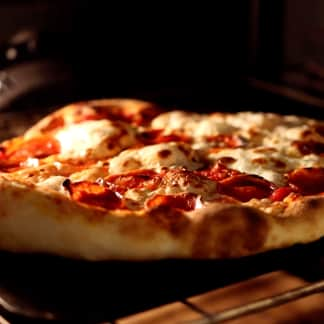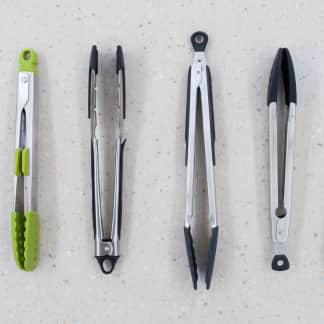For pizzeria-quality pies with exceptionally pillowy, chewy-tender crust, you need an oven that gets very hot—ideally 700 degrees or more. Two electric models, the Breville Smart Oven Pizzaiolo and the Ooni Volt 12 Electric Pizza Oven, reach those temperatures. They preheat quickly, have user-friendly controls, and make it both easy and fun to make outstanding pizza. Because they’re electric, they can be used indoors or outside. They’re co-winners. The Ooni Volt is larger, so it can accommodate a slightly larger stone for slightly larger pizzas, but it is also bulkier and may not fit on all countertops. The Breville Pizzaiolo is compact enough to fit in most kitchens, but its smaller stone means that your pizzas will also be slightly smaller.
What You Need to Know
You can make pizza in your kitchen’s oven with a baking stone or baking steel, but many companies claim that indoor pizza ovens do a better job. Unfortunately, most are disappointing. When we reviewed indoor pizza ovens, we found that they’re generally slow, don’t get very hot, and make pizza that’s mediocre at best.

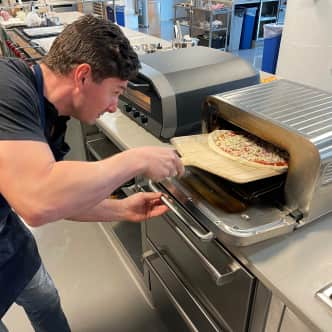
You can make great pizza in your regular oven—but these electric pizza ovens promise to make it easier, faster, and more fun.
When Breville launched the Smart Oven Pizzaiolo in 2019, things changed. This electric model was compact enough to fit on a kitchen counter and both the stone and the air inside the oven exceeded 750 degrees. Now Ooni—one of the biggest names in portable outdoor pizza ovens—has launched an electric pizza oven of its own. Cleverly, the Ooni Volt is marketed for both indoor and outdoor use. Of course, as long as you have an outdoor electrical outlet, the Pizzaiolo can be used outdoors too.
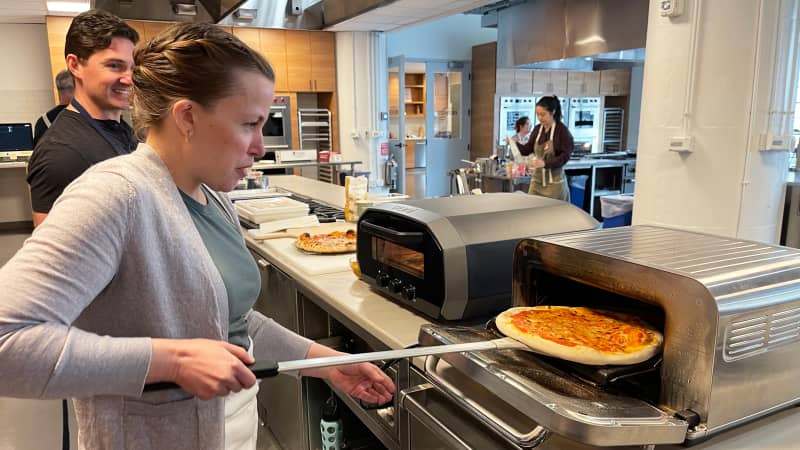
After baking dozens of pizzas in side-by-side tests, we were impressed by both the Ooni Volt and the Breville Pizzaiolo. At about $1,000 and roughly 30 pounds or more, they are both pricey and heavy, but they are well designed and deliver on their promise to make exceptional pizza. They’re best for people who intend to make a lot of pizza. If pizza making is one of your main hobbies and you want an indoor/outdoor appliance to take your pies to the next level, the Breville Pizzaiolo or Ooni Volt might be right for you. Read on to learn more about them.
Tips and Tricks for Making Pizzas in an Electric Pizza Oven
- Divide dough for Thin-Crust Pizza into three balls (instead of two), set aside to proof, and then stretch into 11-inch rounds (instead of 13-inch)
- The dough for Whole-Wheat Pizza can also be shaped into three 11-inch rounds
- Rotate your pizza as it cooks
- Stretch and top your pizza immediately before you cook it; if it sits on the peel for too long, it will stick
- An internal fan helps cool off the pizza oven, so don’t unplug it immediately after use; wait until the fan stops running
What We Liked
- High Temperatures: Both the Breville Pizzaiolo and Ooni Volt are capable of achieving really high temperatures. In our tests, we found that the temperature of the air and baking stones actually exceeded the pizza ovens’ respective maximum settings of 750 and 850 degrees. The difference between 750 and 500 degrees (the highest temperature a home oven can achieve) is significant. Baking pizza at such high heat means that the bottom crisps up and the toppings cook before the interior of the dough has a chance to dry out. Simply put: You can make pizza with tender chew and textural contrast that you cannot get from a home oven. However, the difference between 750 degrees and 850 degrees was negligible. Both ovens got plenty hot for us and produced spectacular pies.
- Speed: Both pizza ovens were fast, taking just 20 minutes each to preheat to their highest temperature settings—much faster than it takes a conventional oven to heat to the comparatively lower temperature of 500 degrees. And at those settings, pizzas baked in about 4 minutes. That means that we could turn on the oven, crank up the heat, and finish baking a pizza in about one-third of the time it takes a home oven to preheat.
- Straightforward Controls: We liked that the ovens were easy to operate. Each had simple, clearly marked dials. On the Pizzaiolo, we selected from one of seven preprogrammed pizza settings. On the Volt, we chose specific temperatures. We also appreciated that the markings on both machines’ dials lit up brightly.
- Customizability: For even greater control, you can dial in specific preferences on each pizza oven. On the Volt, you can adjust the balance between the upper and lower heating on the elements. The Pizzaiolo allows you to customize the darkness of the pizza. You can also go one step further and switch that model to “manual” mode. The functions of the various dials change, so instead of choosing from preprogrammed settings, you select the temperatures for the top and bottom heating elements. An included magnet slips over the dials and changes their descriptions, so it’s always clear which dial does what in both regular mode and manual mode. It’s a clever design feature that looks good and works well.
- Built-In Timer: We appreciated that both models have built-in timers that are easy to set, saving us from having to keep track of another gadget. They also light up brightly and are easy to read at a glance.
Nice to Have
- Bigger, Square Pizza Stones: Bigger stones allow you to make bigger pizzas. Additionally, as we’ve found in our testing of baking stones and steels, launching a round pizza onto a round stone requires precision and finesse. We could still make excellent pizzas on the Breville Pizzaiolo’s round, 11¾-inch stone. However, we appreciated the extra space and wiggle room provided by the 13-inch square stone in the Ooni Volt.
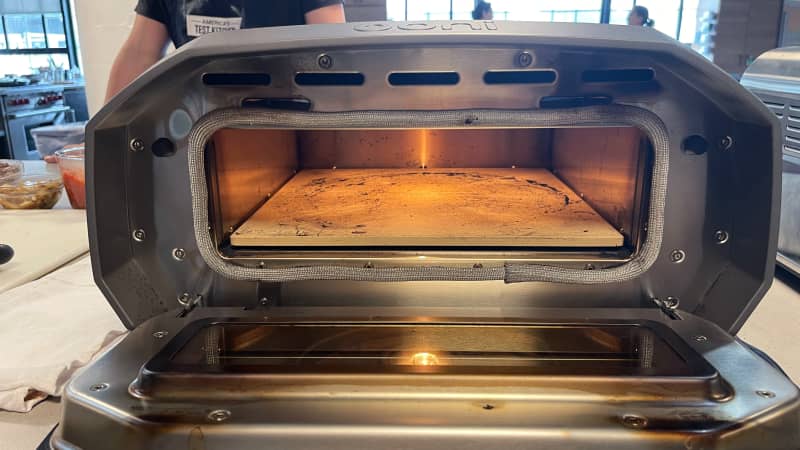
Which Indoor Pizza Oven Should You Get?
Both pizza ovens can open up new possibilities for homemade pizza. In terms of performance, it was a draw: Both make stellar pizza. Ultimately, the decision of which oven to get depends mostly on size. The Ooni Volt is bigger—measuring 25 inches long, it exceeds the depth of many standard kitchen counters on its own and requires more room around it for air flow, so be sure to measure your space before you purchase it. However, that large size allows it to accommodate a bigger stone and one that’s square. This means that you can make slightly larger pizzas and will have an easier time launching and rotating them. The Pizzaiolo is more compact and will fit easily in many kitchens, but it’s a little more difficult to maneuver pizzas on its comparatively smaller, round stone.
The Tests:
- Cook frozen pepperoni pizza
- Make cheese pizza with store-bought pizza dough
- Make thin-crust cheese pizza
- Make loaded thin-crust pizza topped with sausage, peppers, and onions
- Make Neapolitan-style pizza
- For Pizzaiolo: Make pan pizza using included carbon-steel baking pan
- Roast asparagus
- Roast broccoli rabe
- Compare pizza and vegetables to those prepared in our conventional oven
- Record the temperature of the cooking surfaces and air inside the oven at the maximum temperature settings
How We Rated:
- Performance: We evaluated the quality of different styles of pizza prepared in each oven.
- Ease of Use: We considered how easy it was to adjust the pizza oven both using its preprogrammed options and the manual modifications. We also considered how easy it was to load, rotate, and remove pizzas.









